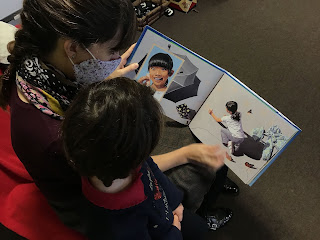Simon writes:
We have three parallel PK classes, with children aged 3 to 5 - Sun, Star and Moon class. At certain times children choose to move between them, and sometimes we teachers get to work alongside each other too. In the first two schools I worked in, I hardly saw other teachers teaching at all, now we see each other in action a lot.
It's interesting to me how, even though we plan together and use the same resources, and for all of us the children and their play is central, there are differences between the about where the buzz is, partly due to the group of students, partly due to the adults.
For Rachel, it's around books. Reading books of course, but also using them as a focus for art, maths, language and drama. There have been weeks when we'd agreed we were going to focus on a book, say The Very Hungry Caterpillar, and looking back afterwards, I've realised that Sun class, with Rachel and Karen's enthusiaasm and expertise around this, have gone a lot deeper into the book.
I didn't want to let the year pass without hearing more about this from Rachel herself, so I asked her some questions, which she kindly agreed to answer:
Simon: What is the most fun for you as a teacher?
Rachel: Reading the class favourite stories that the children can tell with you is fun. I think it is such a lovely shared moment when you can all equally enjoy a book together. My class love Shh! We Have a Plan by Chris Haughton and even those children who have limited English are able to tell the story with me. I also enjoy singing songs with the children, either as a whole group or just while we’re doing an activity and somebody has started singing so we all join in.
What are some of the things you think children get from having a good book read to them?
They can hear how language works, patterns in language, new vocabulary, rhythm etc. They can imagine different experiences or even relate to them. Children can see somebody enjoying reading for pleasure and having fun with the book in how they might use voices or expression. It is also a bonding experience where you enjoy something together.
Can you tell me a few more favourites (yours or your class’s)?
My class: We’re Going on a Bear Hunt by Michael Rosen, Shh! We Have a Plan by Chris Haughton, The Very Hungry Caterpillar by Eric Carle and Neon Leon by Jane Clark
Me: The Bear Under the Stairs by Helen Cooper, Where the Wild Things Are by Maurice Sendak and Pete the Cat by Eric Litwin and James Dean.
What do you think the teacher needs to add in to bring in the most from the book?
Animation, actions and expressions, opportunities for the children to join in. I have seen Karen using dressing up clothes, props and asking children to act out sections as she is reading it and that has worked really well.
Can you give an example of where you’ve developed the book outside of the story time, for further playful exploration?
We looked at The Very Hungry Caterpillar and made caterpillar and butterfly paintings, explored symmetry, used food and also created some counting activities.
We also looked at The Train Ride by June Crebbin and the children ended up creating a train role play area with a little ticket office. Some of the children enjoyed painting trains and playing with the small world train track.
I should say that, as well as helping young children to love books, Rachel does the same with her grown-up friends. We've been recommended Atwoods and Ishiguros and many more, and talking about the books after reading is always so much fun. I asked about this too, this time on messenger (apologies for the typos!).
Talking about Vivian Paley, we have been reading her books this year, me, Rachel and Estelle. They are accounts of her time as teacher of pre-kindergarten and kidergarten children, and they are brilliant. I wish I'd discovered them sooner.
One of the things Paley did was to regularly write down for the children the stories they tell. Later in the day, the children act out the stories. This approach is often called 'helicopter stories'. We're trying to follow it. It's not always easy; we have a lot of children who are just beginning to learn English, and lots who are still find it hard to get going. We're pressing on though, knowing that it's another way into the realm of stories for our children, and one that raises its profile.
Here's an example of some narration:
Rachel and I were remarking how for some children the time they're telling us their story is where we hear them speak most. We're sometimes surprised by how much they can say.
Later in the day, we gather round a 'stage' and while the teacher reads out the story, some of the children act out the story.
It can be hard to find time for acting the stories out; there is so much we want to do in the short time when the class can sit still together - not least read the picture books we love. But, we think it adds to the importance of storytelling, is a way that children's own voices are heard and imagination and ideas are shared - so we're trying to make time for it. We're hoping that more and more children will feel able to join in with the acting, and with the storytelling too!





















Comments
Post a Comment